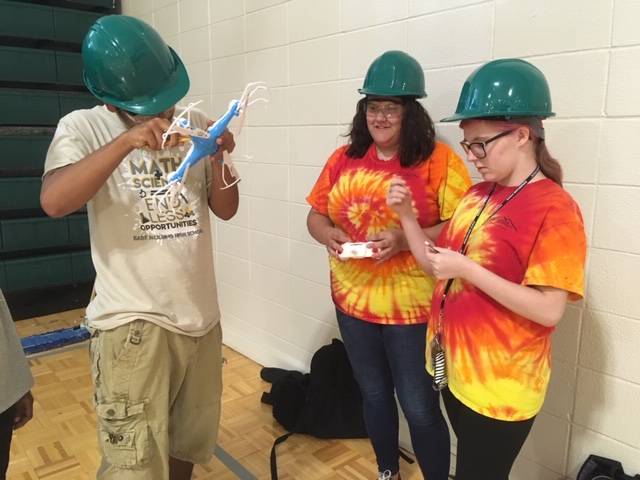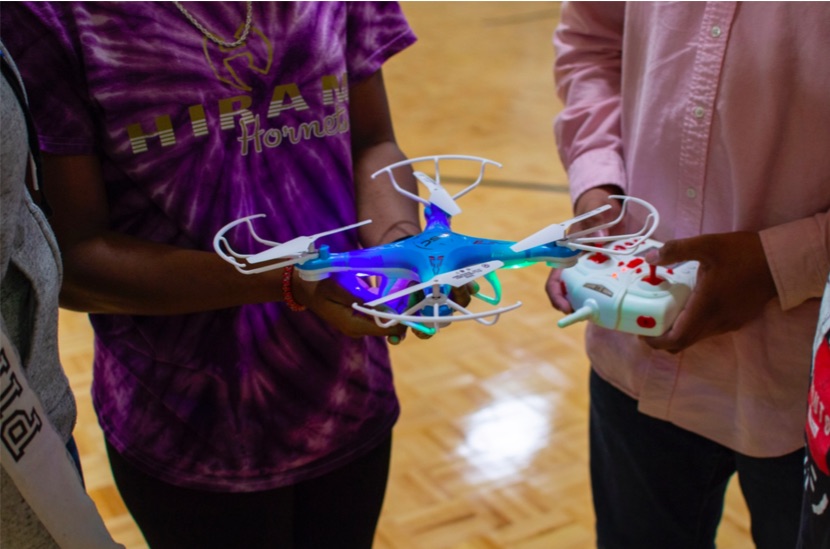
Photo by Stell Simonton
Students (from left) Elio Vargas, Audrey Jeffress and Kayla Linard troubleshoot a drone. The summer class is offered by the Upward Bound TRIO program at Kennesaw State University’s campus in Marietta, Ga.
Kayla Linard stood high in the balcony of the Kennesaw State University gymnasium in Marietta, Ga., holding a white remote control device.
Down on the gym floor, fellow student Audrey Jeffress spoke to her.
“Go up,” she said.
Then: “Go to the right.”
Hovering near the gym floor, a small blue plastic drone with four white propellers rose slightly, moved to the right, then glided through a hoop.
The two students, both rising high school seniors, were part of a drone assembly class in a summer academy offered to students in Kennesaw State’s Upward Bound programs. Students were refining their drone-handling skills and maneuvering the devices through an obstacle course, but they were also getting support in preparing for and succeeding in college.
The six-week summer academy offers core academic classes and electives for ninth through 12th graders and supports seniors who are making the transition to college. The goal of Upward Bound, funded through the federal TRIO grant programs, is to prepare underserved students for success in college or other postsecondary education.
Eighty-eight students from Hiram, East Paulding and Rockmart-Cedartown high schools in Georgia attended the summer academy at Kennesaw.
“We make sure kids have everything they need to get into and succeed in post-secondary education,” said Jennifer Craton, summer activity assistant for the program.
For some students, the summer academy may simply feel like something to do in the summer. But it’s about creating an environment and culture that gives them confidence and encourages them to aim high, Craton said.
“They’re already great people,” she said. But the program is about “showing them what they can do.
“Students have a lot of barriers outside of school.” she said.
It’s hard to focus on educational opportunities “if you don’t know where your next meal is coming from.” Craton said.
Big income gap in college graduation rate
Upward Bound is aimed at students with limited income, a group far less likely to graduate from college. Only 13% of students from the lowest-earning families in the United States (the quartile with the lowest incomes) get a four-year degree by age 24. That’s compared with 62% of students from the highest-income families (the top quarter of the population).
While the high school and college graduate rate is increasing, inequalities are growing, according to a 2019 report by the Council for Opportunity in Education. In 2016, the average cost of college equaled 94% of a low-income family’s income. In 1994, it equaled 45%. With less state and local funding per student, families now shoulder a larger proportion of college expenses than they did three decades ago. Students take on more debt, with African-American college graduates, at $34,000, having the highest average debt.
Before the drone class, Dalton J. Lemelle Jr., associate director at Kennesaw State University’s Paulding site, stood just inside the campus mathematics building and pulled out a thank you note.
It was from Upward Bound student Jillian Rodriguez, a rising senior at Hiram High School, who had just returned from the Congress of Future Medical Leaders in Lowell, Mass. Encouragement from Upward Bound instructors had helped her apply for and attend the conference, she wrote. She had stayed on a college campus at the conference, heard Nobel Laureates talk about medical research and watched a knee operation.

Photo by Jennifer Craton
The federally funded program prepares students with limited income for success in college. This class lays a foundation for future engineering study.
A moment later, Jillian herself came by from a summer academy class where she was getting help on filling out the FAFSA form required for financial aid in college.
“My parents are Hispanic,” she said. “They don’t know a lot about college.”
Her goal is to become a doctor. The conference was thrilling and gave her ideas for future research, she said.
Attention from instructors
In the gym, drone instructor Brendon Barclay, a senior at Kennesaw, was showing students how to make drones pick up and carry loads. Two drones, each attached to one end of a rope, rose from the floor. Their controllers moved them forward so that the rope dipped in front of a third student, who prepared to attach a small payload to the rope. But the drones skittered out of place.
Barclay helped troubleshoot.
“Are you communicating?” he asked the two students. “How are you communicating?”
Four instructors worked with 15 students in the drone class. The high instructor ratio in all the summer academy classes was intended to provide one-on-one interaction that students may not get in school.
During the school year, 180 students are served by Kennesaw’s Upward Bound program.
Upward Bound began in 1964 as part of President Lyndon Baines Johnson’s War on Poverty and is now funded through the U.S. Department of Education TRIO programs.
Upward Bound programs offer support services such as supplemental courses, tutoring, academic advising, college exposure and application assistance, college entrance exam preparations and financial aid assistance.
They provide instruction in literature, composition, math, laboratory science and foreign language. Students enter the program in ninth or 10th grades and may stay through the summer after high school. Each also offers summer program that simulates a college-going experience.
“When you compare the success rates of students who participate [in Upward Bound], they do better than other low-income students,” said Kimberly Jones, vice president for public policy and communications at the Council for Opportunity in Education. “As recently as 2016 the Department of Education found that high school students from the poorest families had only a 48% college enrollment rate but Upward Bound students had an 86% college enrollment rate.”
The program has several components that work together, she said.
“It’s wholistic. It combines both academic, family support and peer support. A cohort of students on this path together,” she said.





























